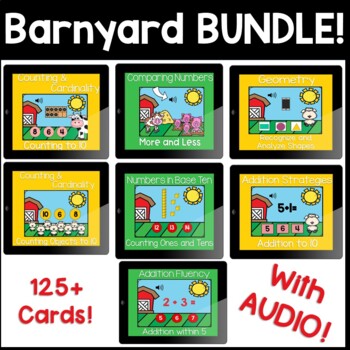Numbers to 10 | Number Sense | Comparing Numbers | BOOM Cards™
- Zip
- Internet Activities
Products in this Bundle (7)
showing 1-5 of 7 products
Description
Numbers to 10 | Number Sense | Comparing Numbers | BOOM Cards™
This growing bundle will keep your students will enthusiastic about developing their number sense and counting skills until the cows come home! This barnyard themed BUNDLE of BOOM Cards is a great addition to your math centers and distance learning toolbox. Students will use addition to solve addition and subtraction fluency, adding and subtraction within 10, kindergarten geometry and shapes, and place value understanding.
This bundle is now complete! It includes 7 decks focused on kindergarten math standards. This product includes links to access each deck hosted on BOOM Learning.
What does this listing include?
-Barnyard Math: Number Identification with Ten Frames
-Barnyard Math: Addition Within 10
-Barnyard Math: Comparing Numbers
-Barnyard Math: Place Value- Numbers 11-19
-Barnyard Math: Addition and Subtraction Fluency With 5
Terms
Copyright © Michelle Staley. All rights reserved by the author. This product is to be used by the original downloader only. Copying for more than one teacher, classroom, department, school, or school system is prohibited. This product may not be distributed or displayed digitally for public view. Failure to comply is a copyright infringement and a violation of the Digital Millennium Copyright Act (DMCA). Clipart and elements found in this PDF are copyrighted and cannot be extracted and used outside of this file without permission or license. Intended for classroom and personal use ONLY. See product file for clip-art and font credits.
Important Information from BOOM Learning
To use Boom Cards, you must be connected to the Internet. Boom Cards play on modern browsers (Chrome, Safari, Firefox, and Edge). Apps are available for Android, iPads, iPhones, and Kindle Fires. For security and privacy, adults must have a Boom Learning account to use and assign Boom Cards. You will be able to assign the Boom Cards you are buying with "Fast Pins," (play provides instant feedback for self-grading Boom Cards). Fast Play is always a free way for students to engage with Boom Cards decks. For additional assignment options you'll need a premium account. If you are new to Boom Learning, you will be offered a free trial of our premium account. Read here for details: http://bit.ly/BoomTrial.
Common Core State Standards:
Know number names and the count sequence.
CCSS.MATH.CONTENT.K.CC.A.1 Count to 100 by ones and by tens.
CCSS.MATH.CONTENT.K.CC.A.2 Count forward beginning from a given number within the known sequence (instead of having to begin at 1).
CCSS.MATH.CONTENT.K.CC.A.3 Write numbers from 0 to 20. Represent a number of objects with a written numeral 0-20 (with 0 representing a count of no objects).
Count to tell the number of objects.
CCSS.MATH.CONTENT.K.CC.B.4 Understand the relationship between numbers and quantities; connect counting to cardinality.
CCSS.MATH.CONTENT.K.CC.B.4.A When counting objects, say the number names in the standard order, pairing each object with one and only one number name and each number name with one and only one object.
CCSS.MATH.CONTENT.K.CC.B.4.B Understand that the last number name said tells the number of objects counted. The number of objects is the same regardless of their arrangement or the order in which they were counted.
CCSS.MATH.CONTENT.K.CC.B.4.C Understand that each successive number name refers to a quantity that is one larger.
CCSS.MATH.CONTENT.K.CC.B.5 Count to answer "how many?" questions about as many as 20 things arranged in a line, a rectangular array, or a circle, or as many as 10 things in a scattered configuration; given a number from 1-20, count out that many objects.
Identify and describe shapes.
CCSS.MATH.CONTENT.K.G.A.1
Describe objects in the environment using names of shapes, and describe the relative positions of these objects using terms such as above, below, beside, in front of, behind, and next to.
CCSS.MATH.CONTENT.K.G.A.2
Correctly name shapes regardless of their orientations or overall size.
CCSS.MATH.CONTENT.K.G.A.3
Identify shapes as two-dimensional (lying in a plane, "flat") or three-dimensional ("solid").
Analyze, compare, create, and compose shapes.
CCSS.MATH.CONTENT.K.G.B.4
Analyze and compare two- and three-dimensional shapes, in different sizes and orientations, using informal language to describe their similarities, differences, parts (e.g., number of sides and vertices/"corners") and other attributes (e.g., having sides of equal length).




